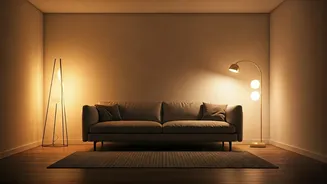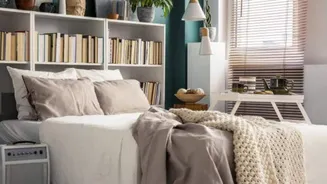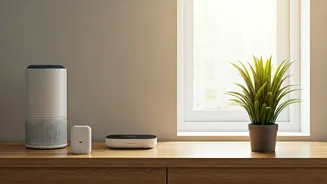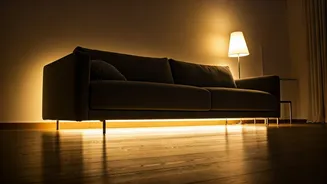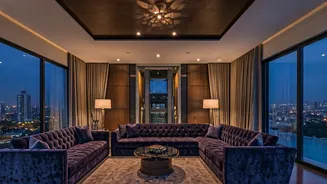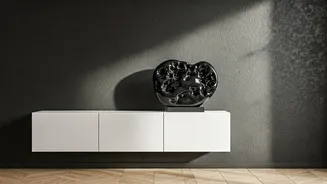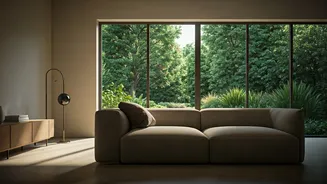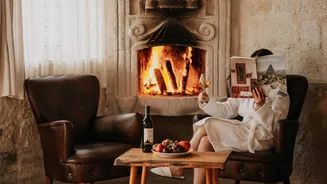Setting the Stage
Creating the perfect mood lighting in your home is akin to painting with light, and the impact of the right kind of illumination can be transformative.
Before you start, think about the function of each area, whether it is a cozy reading nook or an energetic kitchen, because this will guide the selection of appropriate lighting. The goal is not just about brightness; it is about setting the tone. Consider how different light sources can create distinct moods, from the gentle glow of warm white light for relaxation to the invigorating cool tones of natural light for a workspace. Start by assessing your rooms. What activities will primarily take place there? How do you want people to feel in these spaces? Answer these questions, then proceed.
Living Room Lighting
The living room is the hub of relaxation and social interaction, so the lighting scheme should reflect this versatility. The key is layering light sources to avoid flat and uninviting spaces. Begin with overhead lighting, such as a chandelier or recessed lights, to provide general illumination. However, supplement this with task lighting, such as a floor lamp beside a sofa or a table lamp on a side table, for reading and specific activities. Use accent lighting, like spotlights on artwork or wall sconces to highlight architectural features or add visual interest. Consider dimmers on all light sources to easily adjust the ambiance. Mix and match light fixtures to create visual interest and personality in your living room.
Bedroom Ambiance
In the bedroom, creating a tranquil atmosphere is essential for rest and relaxation. Soft, diffused lighting is the best approach. Avoid harsh overhead lighting that can disrupt your sleep cycle. Instead, opt for bedside lamps with warm-toned bulbs to cast a gentle glow. If you have overhead lighting, use a dimmer to control the intensity, as needed. Consider incorporating accent lighting, such as fairy lights or string lights, for a whimsical touch. Remember, the goal is to create a calming sanctuary where you can unwind. Think about adding a dimmer to your main light source to customize the ambiance even further.
Kitchen Illumination
The kitchen requires a blend of functionality and style, as it's a space for cooking and often a place for gathering. Layering is also crucial in the kitchen. Combine general lighting, such as recessed lights or a ceiling fixture, with task lighting. Place under-cabinet lights to illuminate countertops for food preparation and add pendant lights over an island or breakfast bar to define the space and add a decorative touch. Ensure you have good task lighting in areas where you prepare food. Cool-toned LED lights are often preferred for their brightness and energy efficiency, while warmer tones create a more inviting atmosphere for dining. Balance both for an ideal result.
Dining Area Magic
The dining area should feel welcoming and conducive to conversation. A key element is the dining table's lighting. A pendant light or chandelier placed directly above the table is ideal. The light fixture should be proportional to the table size. Use a dimmer to control the brightness, allowing you to create different moods for casual meals or formal dinners. Consider using warm-toned bulbs to enhance the atmosphere. Additionally, you can add accent lighting, such as wall sconces or candles, to create a softer, more intimate setting. Remember to create an inviting space for your family and guests. The light is a tool.
Bathroom Lighting
Bathroom lighting is crucial for both functionality and aesthetic appeal. Start with overhead lighting, such as recessed lights or a stylish flush-mount fixture, to provide overall illumination. Add task lighting around the mirror, such as sconces on either side, to eliminate shadows and provide ample light for grooming. Choose moisture-resistant fixtures to ensure safety. Consider incorporating a dimmer on your overhead lights to customize the ambiance. If you have the space, you can include accent lighting, like in-shower lighting, to add a spa-like touch. The key is to blend functionality with a relaxing ambiance.
Hallway Brilliance
Hallways often get overlooked, but proper lighting can make them more welcoming. Install overhead lights, like recessed lights or flush-mount fixtures, to provide general illumination. Consider using a combination of lights to provide both ambient light and spotlight the decor. Add accent lighting, such as wall sconces or artwork lighting, to create visual interest. For longer hallways, use a layered approach with multiple light sources to avoid a tunnel effect. Motion-sensor lights can enhance convenience and safety, particularly in hallways. Remember, a well-lit hallway can seamlessly connect different areas of your home and set the tone for the entire space.
Outdoor Lighting
Extend your home's ambiance to the outdoors with thoughtfully designed lighting. Outdoor lighting enhances security and extends the usability of your outdoor spaces. Consider installing path lights along walkways to provide safe navigation. Use spotlights to highlight architectural features, trees, or landscaping. Install wall-mounted lights near doors for security and convenience. Consider using energy-efficient LEDs designed for outdoor use. For the most aesthetic result, incorporate landscape lighting. Consider solar-powered options for an eco-friendly approach. Outdoor lighting can transform your yard from a simple space into a delightful living area.
Choosing the Bulbs
The choice of light bulbs plays a vital role in creating the desired mood. Consider the color temperature (measured in Kelvin) and the brightness (measured in lumens) of the bulbs. Warm white light (2700K-3000K) is suitable for relaxation, while cool white light (3500K-4100K) is great for task areas. LED bulbs are energy-efficient, long-lasting, and available in a wide range of color temperatures. The brightness of the bulbs should align with the size and function of the room. Always check the light fixtures for compatibility with various bulb types. Consider using smart bulbs that allow you to customize the color temperature, brightness, and schedule.
Style and Ambiance
Ultimately, creating the perfect mood lighting is a personal experience, reflecting your style. Embrace creativity and have fun experimenting with different lighting techniques. Consider the style and design of your home to guide your choices. Incorporate decorative light fixtures such as chandeliers, sconces, or pendant lights to infuse personality. Use dimmers to adapt the brightness to your activities, whether you are reading, entertaining, or simply relaxing. Lighting is an important element. Consider your home's architectural style and existing décor to create a cohesive lighting scheme. Ultimately, design spaces that reflect your personality.
